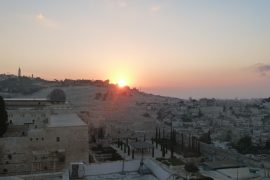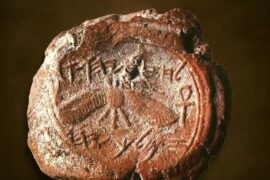The seventh day of the month of Adar is recognized among our people as the day Moshe, our greatest prophet and leader, entered and left this world.
Moshe’s life, especially the events surrounding his birth and death, are a unique example of the power of one’s personal relationship with HaShem, and the importance of bitaḥon – complete confidence in HaShem’s ultimate goodness. This date is marked every year by fasting among members of the ḥevra kadisha, Jewish burial societies, in recognition of the total ḥesed that HaShem performed for Moshe at the end of his life, burying him through His Divine power.
The absence of a man-made burial site for our greatest leader might seem strange at first glance but there are multiple layers of Divine providence in this absence.
First, Moshe’s passing outside the land of Israel, and subsequent burial on the far side of the Jordan River, could have proven problematic for the nation’s next step in conquering Eretz Yisrael. Had the people erected a memorial site, it would have proven a strong incentive to remain on the other side. However, since he was buried by HaShem, the people were able to more comfortably accept Yehoshua’s leadership and cross the Jordan.
Beyond this, burial is considered a great ḥesed (kindness) among our people. It also demands a deep level of respect for the deceased, and the dignity of the body, until it has been properly buried.
By tending to the burial of Moshe, deserving of the highest honor, HaShem ensured the greatest level of dignity for a man far too humble to demand such honors for himself.
HaShem’s ultimate ḥesed to Moshe is also present around the events of his birth. Moshe was born at a time of great trouble for Bnei Yisrael, when all male children were thrown to their deaths in the Nile.
From his birth, Moshe was hidden in order to protect him, making Brit Mila (circumcision) impossible. Yet, in His great ḥesed and ultimate knowledge of Moshe’s future role, HaShem performed Moshe’s Brit Mila Himself, and the baby was born already circumcised.
HaShem performed a true ḥesed for Moshe’s parents as well, rescuing them from the decision to either endanger their son’s life or exclude him from the covenant between Bnei Yisrael and HaShem. The baby’s birth on the seventh of Adar and Moshe’s passing on the seventh of Adar, 120 years later, mark another great ḥesed that HaShem performed.
According to B’reshit 6:3, 120 years is the full, optimal length of man’s lifespan. It has become a symbol of fullness of life in Hebrew tradition. 120 is also the number of members of the Anshei Knesset HaGdola, the Israelite legislative body, and 12, the number of tribes in Israel, also connotes a sense of completeness.
Moshe, having lived 120 years to the date of his birth, completed his role as leader, as prophet, as judge. From beginning to end, Moshe’s life was marked by HaShem’s ḥesed, as an example to Bnei Yisrael.
For a nation freed from bondage, conditioned to have their needs dependent on their Egyptian masters, this example was necessary to instill within the nation the bitaḥon that all would be provided as needed if they followed in the ways of HaShem, as demonstrated and taught by Moshe.
As we continuously gain greater freedom as a people independent in our own land, we must take this seventh of Adar to remind ourselves of HaShem’s ultimate ḥesed to us in this incredible generation. Rather than rely on earthly powers and worldly leaders to ensure our national needs, we must instead maintain bitaḥon that so long as we continue in the ways of our Torah, all will be provided, despite the odds stacked against us.





